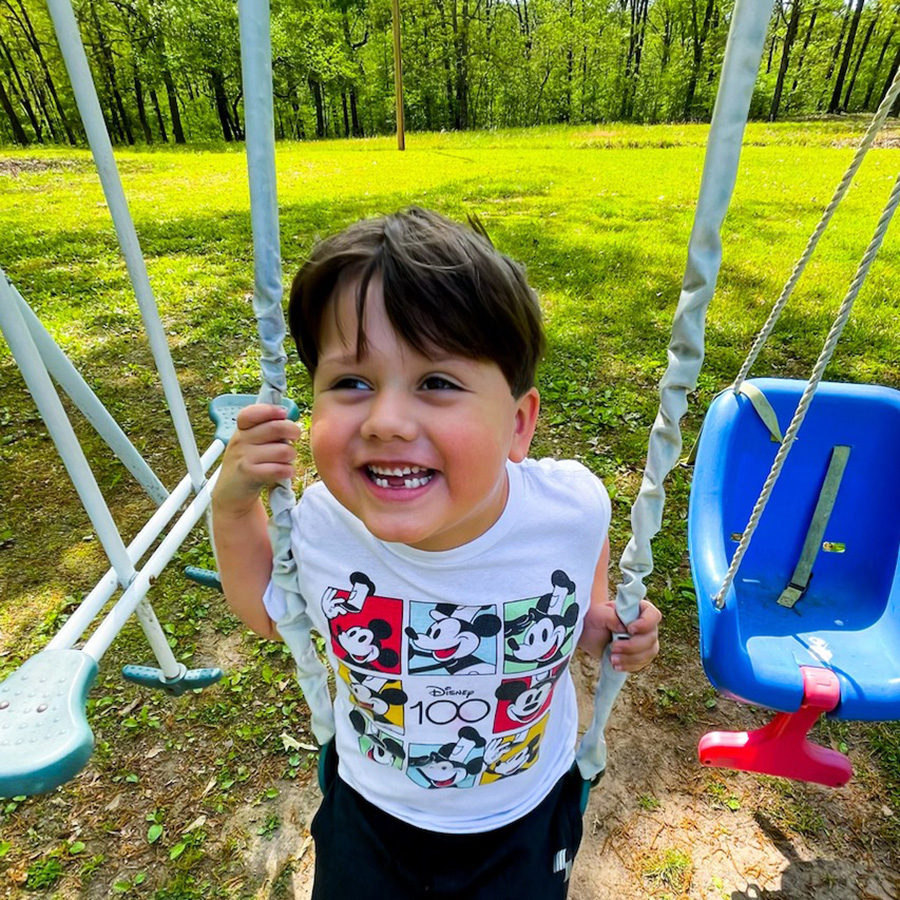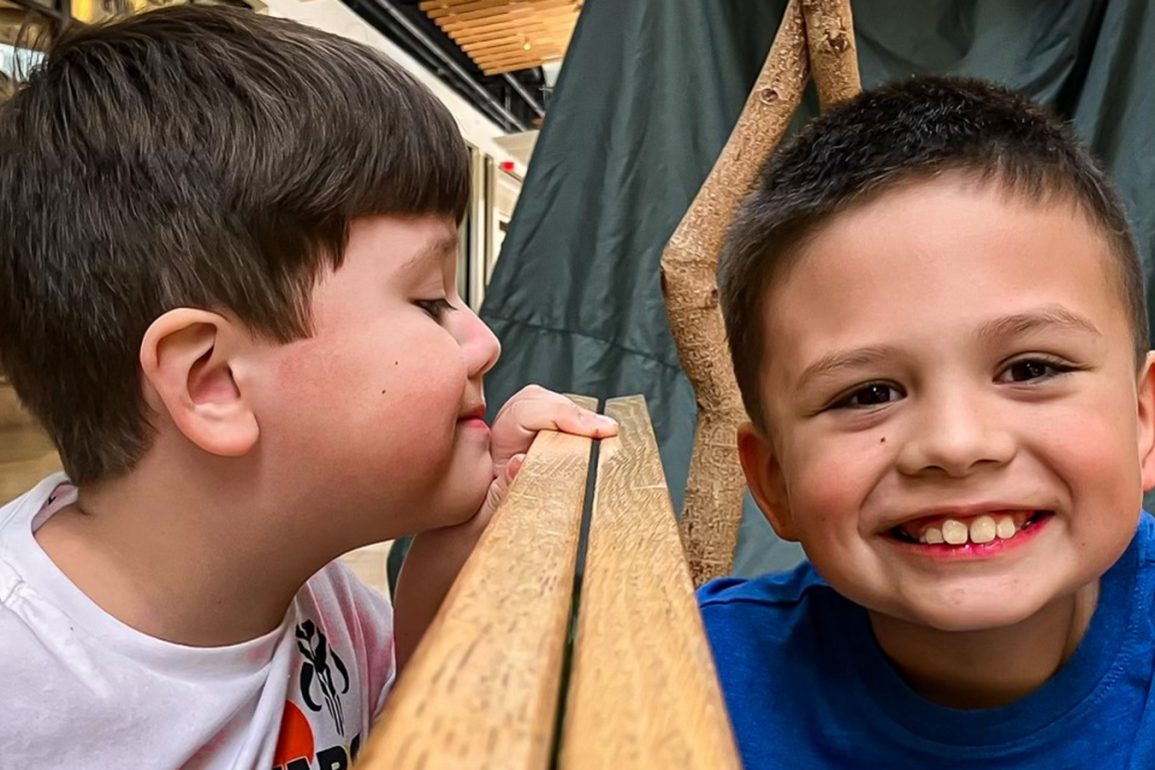Candy Mink Springs, Okla.—Until Sequoyah Littledeer was almost four, he didn’t speak. As a non-verbal infant and toddler, his parents struggled to understand and interpret their youngest son’s meltdowns as they navigated a disordered minefield of sensory issues. Tastes, textures, clothes, colors and sounds sent him into screaming fits that seemed to come out of nowhere.
As he got older, other atypical behaviors also began to emerge, like spending hours organizing forks, spoons and knives in ever more elaborate fractal patterns, coordinating pens and markers in rigid color schemes and obsessing over Hot Wheels.
“He couldn’t speak, so we didn’t know what was bothering him,” says his father, Troy Littledeer, who is the media director for the United Keetoowah Band of Cherokee Indians of Oklahoma, one of three federally recognized Cherokee bands in the United States. “At first, it was just little things, but over time we began to realize that he not only had sensory issues, but he also had foot problems and was substantially delayed in his milestones. So getting him checked out before he started preschool became critical.”
At almost three-years-old, Sequoyah was about to begin preschool at Dahlonegah Elementary (pronounced Dah-lona-ghee, which means “yellow” in the Cherokee language). A small pre-K–8 school on the Cherokee Nation Reservation, Dahlonegah is a public institution serving a large majority of Native students from the surrounding communities, including historic Candy Mink Springs, where Littledeer’s family has lived for generations since the Trail of Tears in the 1830s.
With limited resources available on the reservation, the Littledeers began a desperate search to find help for their son’s multiple issues that they had to organize and coordinate themselves. Using their own insurance and financial resources, they went out-of-state to Arkansas to obtain occupational, speech and physical therapy services to begin addressing his sensory issues, help him manage his emotions and work on coordination and mobility. After being taught how to use a visual chart, Sequoyah’s first-ever sentence was, “I want juice,” which was a game-changer in terms of his ability to finally communicate his needs.
“We could have gone to Indian Health Service, but they have waitlists that go on for months and years, and I knew we’d be waiting a long time to even get him evaluated, much less the therapies he would need to be successful in a school setting,” says Littledeer. “But he didn’t have months and years, because at that point it would have been almost too late and he would be falling further behind.”
At first, the Littledeers were skeptical about going off the reservation to seek help, due in part to a sense of leeriness with non-Native service providers who may not understand them and their particular cultural needs and values.
“One of our first thoughts was: ‘How are they going to treat us?’” says Littledeer. “For a lot of Natives, there’s always an apprehension with people on the outside because of how we’re treated, so we were cautious at first.”

Today, however, their fears have been assuaged by Sequoyah’s ongoing progress and enthusiasm with his therapists. “He loves it there,” says Littledeer. “They’re just a part of our everyday life and he’s doing great.”
But the legally-mandated services he was supposed to receive at school, on the other hand, tell a different story. Now five-years-old and getting ready to start kindergarten next fall, Sequoyah has had an Individualized Education Plan (IEP) at Dahlonegah for two years that specifies 90 minutes of services per week, which has been spotty and inconsistent, or not provided at all, says Littledeer.
“He started his second year of pre-K in August 2023, but he wasn’t pulled out for speech therapy until October,” says Littledeer. “So he had 12 weeks of no services and we were never notified that he wasn’t getting them. And then some of what was suggested included watching Youtube videos—not one-on-one therapy, which was not helpful at all for a four-year-old and don’t really count as ‘services’ that they’re getting funding to provide.”
Moreover, they were given no instructions or directions to assist Sequoyah with his therapy at home. “We’re not trained speech therapists, so we wouldn’t have any idea if he was doing it correctly or not,” says Littledeer.
Thus, to keep up with Sequoyah’s needs and ensure that he did not fall behind his grade level at school, the Littledeers have continued taking him to his private therapists in Arkansas to ensure that he receives consistent and ongoing occupational, speech and physical therapy to make up for the gaps in his IEP services at school.
But the battle to get Sequoyah the help he needed also came with hidden costs to the Littledeers, including missed workdays, travel time and a variety of out-of-pocket expenses that illustrate how Native parents are forced to navigate both inside and outside an educational system that has failed their special needs children.
A Systemic Breakdown
The Littledeer’s story has become a familiar refrain for thousands of Native American and Alaska Native families across the country, who say their children are not being provided legally-mandated special education services and assistance that is required under the Individuals with Disabilities Education Act (IDEA)—regardless of whether the schools are local public schools (as in the case of Dahlonegah), tribally-controlled public schools, or schools operated by the Bureau of Indian Education (BIE).
The IDEA is a federal law whose purpose is to provide “free and appropriate public education that emphasizes special education and related services designed to meet their unique needs and prepare them for further education, employment, and independent living.”
But an Early Learning Nation magazine investigation into special education in Indian Country has revealed a systemic breakdown—from the federal level to local school districts—in failing to provide services to Native American students with disabilities, most of whom come from some of the poorest, most remote and disadvantaged communities in the entire country.
Compared to other populations, the unequal access to vital early interventions, educational services and related services for Native students with special needs is not only a violation of their rights under the law, it also represents a profound breach in the educational obligations for which tribes specifically negotiated when in entering into treaties in the 1800s that saw the vast diminution of their lands.
Whether from noncompliance with IDEA requirements for both education services and related services—including failure to implement IEPs, shortfalls in services, no services at all, inconsistent and contradictory reporting, to a lack of oversight, accountability, poor monitoring and funding management—Native students with disabilities are among the least served and most vulnerable population in the entire country.
According to the National Center for Educational Statistics, Native Americans represent roughly 2.6 percent of the total population in the United States, and yet they have the highest percentage of students served under IDEA of any racial group at 19 percent.
Diana Cournoyer (Oglala Sioux) is the executive director of the Washington, D.C.-based National Indian Education Association (NIEA), the leading advocacy organization for Native American K-12 education in the United States. She believes that some of the challenges in providing special education services to Indigenous students include delayed identification of disabilities, as well as a shortage of qualified teachers and service providers.
“Generally speaking, the students with, say, down syndrome, severe autism or maybe a missing limb are easier to identify—but that leaves out a large number of kids whose disabilities may not be as visible,” says Cournoyer, who has been in Indian education for decades. “What we’re finding are students who aren’t being identified until late elementary and middle school. And because of a lack of services and support, some of the kids might be one, two or three grades behind, which presents a major challenge to getting them the help they need and reducing dropout rates.”
Cournoyer is a member of the Oglala Sioux Tribe of South Dakota, whose school district has only one or two service days per month to provide all services for the entire district due to a lack of special services staff. Thus, many Native parents on many of the reservations in South Dakota are also forced to find services hours away in either Rapid City, Pierre or Sioux Falls. “It’s costly and time consuming with all that travel, but what choice do they have?” she says.
Moreover, she says, the process should begin in early childhood education, when potential issues usually begin to emerge.
“Most Head Start teachers are not trained to watch for developmental delays when the kids are two-, three- and four-years-old,” she says. “Many times, the child may be nonverbal, but people just think that’s normal—they don’t understand what a delay looks like. That needs to change.”
Cournoyer says that one of the most practical solutions lies in the ability of Native communities to “grow their own,” meaning identifying and educating local teachers, service providers and staff with education and training in order to meet the needs of their most vulnerable students.
“We need to invest in educators and for people to go get their speech therapy degree, for example, which can be done online,” she says. “We have mothers, grandmothers and aunties with kids and relatives in the system who are all fed up because their IEPs are not being served.”
A New Beginning
Now a rambunctious and very verbal five-year-old, Littledeer reports that most of Sequoyah’s issues have either begun to resolve or have been substantially reduced in their severity.
Currently, he’s phasing out of occupational therapy, but will remain at the facility in Arkansas to continue his speech and physical therapy for the foreseeable future.
“He has definitely come a long way from where we began,” says Littledeer. “It’s been a lot of work and sacrifice, but we also believe in him, because he’s very smart and we hope his story will help other people to know they’re not alone or the only ones dealing with the lack of support from their school districts.”
But for thousands of Native special needs students across the country, access to special education services remains one of the biggest challenges in Indian education.
“We’ve had these problems for a very long time, and there’s a growing sense of frustration because it makes no sense,” says Cournoyer. “Therefore, we’ve got to change the system to address the unique needs of our special needs students because that’s what our ancestors fought for and there has to be a way to take back control of our education.”

Suzette Brewer
Suzette Brewer is a writer and producer specializing in federal Indian law and social justice issues, having written extensively on Indian Child Welfare, the Supreme Court, violence against Native women, education and environmental issues on Indian reservations.
She has written for National Geographic, The Dallas Morning News, The Denver Post, Scripps News and many others. Her published books include Real Indians: Portraits of Contemporary Native Americans and America's Tribal Colleges; and Sovereign: An Oral History of Indian Gaming in America.
She is the 2015 recipient of the Richard LaCourse-Gannett Foundation Al Neuharth Investigative Journalism Award for her work on the Indian Child Welfare Act; a 2018 John Jay/Tow Juvenile Justice Reporting Fellow for reporting on juvenile justice in Indian Country; and a 2020 recipient of the Robert F. Kennedy Human Rights Grand Prize for the documentary A Broken Trust for Scripps News Service. She is a member of the Cherokee Nation and is from Stilwell, Oklahoma.



